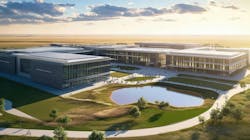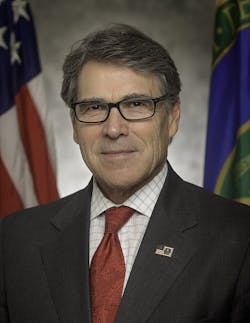Fermi America Promising 600-MW Off-Grid Gas Power for Texas Panhandle AI Campus
A power generation and off-grid project development startup co-founded by former U.S. Energy Secretary and Texas Gov. Rick Perry is partnering with Texas Tech University on ambitious plans to build an $11 billion connected natural gas and artificial intelligence (AI) data center campus in Amarillo.
Fermi America is touting its plan of an “Amarillo HyperGrid” as the next generation in on-site power development to meet growing AI and cloud-based data center demand. The first phase will bring in six Siemens Energy SGT800 gas-fired turbines and one SST600 steam turbine to deliver about 478 MW of co-located and combined heat and power for the proposed AI campus in the Texas Panhandle.
Fermi America was co-founded by a team that includes American private equity investor Toby Neugebauer and Perry, who was the energy secretary in President Donald Trump’s first administration and also Texas governor from 2000 to 2015. The company is named after Italian physicist Enrico Fermi, who played a significant role in the Manhattan Project to develop nuclear power during World War II.
Although gas-fired power is the initial behind-the-meter power solution for the planned Amarillo HyperGrid, Fermi America reportedly will also seek federal Nuclear Regulatory Commission (NRC) approval to build utility-scale reactor plants alongside the Amarillo AI site.
Many in the U.S. contend that AI is a national security issue and off-grid power is the best way to fuel those heavy loads. While natural gas is abundant within the nation, nuclear power can operate at consistently high-capacity factors and does not generate carbon emissions.
Behind-the-meter power is the only solution to ensure “America’s AI dominance,” Neugebauer said in a statement. “Without it, we're handing China the keys to AI. There will only be one winner."
In the meantime, the project’s first gas-fired installation also will utilize selective catalytic reduction to reduce total emissions from the combined-cycle turbine power generation, according to the Fermi America statement. The company’s second power-unit acquisition, which closed last month, will add a set of three secondary market General Electric industrial gas turbines and a paired steam turbine which previously operated to provide power for an industrial customer in New Jersey.
All of those previously used GE units will be refurbished and made operative in simple cycle mode.
"The executed agreements will allow Fermi America to acquire highly reliable, energy-efficient, and environmentally advanced power generation systems to support the artificial intelligence campus," added Fermi America Chief Power Procurement Officer, Larry Kellerman. "The initial fleet represents ISO rated capability of over 600 MW of power generation equipment that is available for shipment and refurbishment, avoiding multi-year Original Equipment Manufacturer (OEM) lead times."
West Texas also is home to the Permian Basin oil and gas play which is the most prolific in the U.S.
The Texas Tech University System released a statement saying the Fermi America project will "create one of the most significant power campuses in the U.S. and the largest advanced energy, private grid and intelligence development in the world" on its 5,800-acre campus in Amarillo.
"The Texas Tech University System is proud to partner with Fermi America on this historic endeavor," Chancellor Tedd L. Mitchell said in a statement. "Texas is the energy capital of the world, and this campus will not only be the largest energy and data complex of its kind, but also a testament to the unshakable spirit of our system, the Texas Panhandle and this great state."
Next-generation combined cycle gas-fired power installation as a starter would be cheaper and quicker to build while also contributing less CO2 emissions compared with current coal and gas generation, the company says. Fermi America hopes to build the first of the nuclear power installations by 2032.
Utility-scale nuclear power plants currently generate about 18% of total U.S. electricity, but building new plants is time consuming and hugely expensive. Southern Co.’s Vogtle Unit 3 and 4 reactor expansion project, while now delivering the single biggest carbon-free generation nationwide, took about a decade and cost close to $35 billion to add the two units.
Details on the partnership with Texas Tech University are not clear yet, nor what kind of financial backing the company has beyond its associations with Neugebauer and Perry.
And while Fermi America is seeking federal nuclear regulatory approval, its appeal is first to the Trump Administration, which is seen by many as seeking to pull oversight power away from the NRC and place it within the White House, according to some reports.
The Trump-led U.S. Department of Energy has announced plans to streamline advanced reactor project development and reduce the lengthy review processes of the NRC.
About the Author
Rod Walton, EnergyTech Managing Editor
Managing Editor
For EnergyTech editorial inquiries, please contact Managing Editor Rod Walton at [email protected].
Rod Walton has spent 17 years covering the energy industry as a newspaper and trade journalist. He formerly was energy writer and business editor at the Tulsa World. Later, he spent six years covering the electricity power sector for Pennwell and Clarion Events. He joined Endeavor and EnergyTech in November 2021.
Walton earned his Bachelors degree in journalism from the University of Oklahoma. His career stops include the Moore American, Bartlesville Examiner-Enterprise, Wagoner Tribune and Tulsa World.
EnergyTech is focused on the mission critical and large-scale energy users and their sustainability and resiliency goals. These include the commercial and industrial sectors, as well as the military, universities, data centers and microgrids. The C&I sectors together account for close to 30 percent of greenhouse gas emissions in the U.S.
He was named Managing Editor for Microgrid Knowledge and EnergyTech starting July 1, 2023
Many large-scale energy users such as Fortune 500 companies, and mission-critical users such as military bases, universities, healthcare facilities, public safety and data centers, shifting their energy priorities to reach net-zero carbon goals within the coming decades. These include plans for renewable energy power purchase agreements, but also on-site resiliency projects such as microgrids, combined heat and power, rooftop solar, energy storage, digitalization and building efficiency upgrades.


